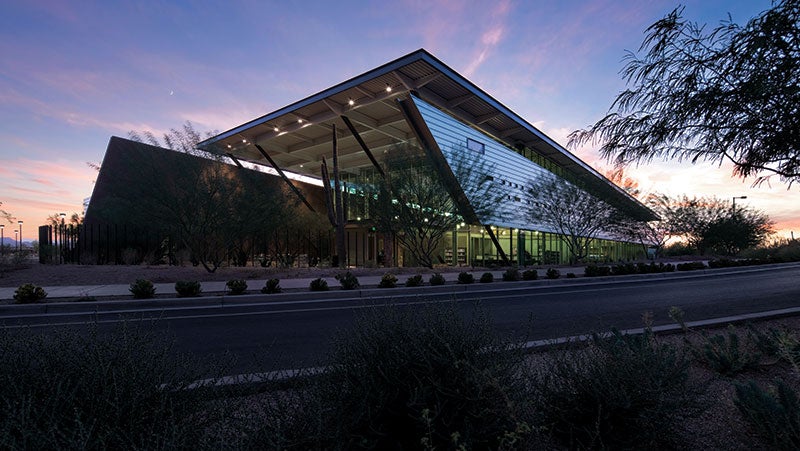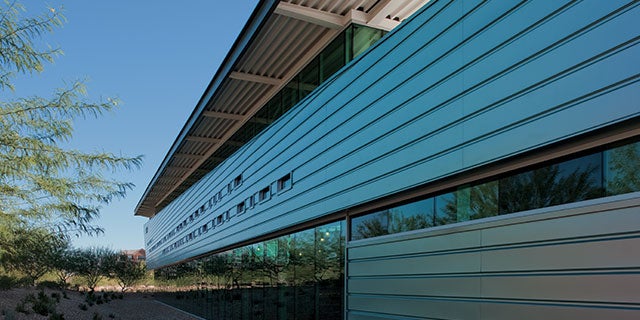Set delicately above a flowing arroyo and among native cacti, the Appaloosa Branch Library is a 21,500 square-foot building occupying four-and-a-half acres of Sonoran desert. Lead architect Jeremy Jones, AIA, LEED AP, was charged with creating an attractive, functional community library that blended seamlessly with the local environment while fulfilling the city's mandate to earn LEED® certification for its newest municipal structure.

To achieve these directives, Jones envisioned the building as a mirage in visual harmony with its setting and a light footprint on its delicate environs. He was able to attain these goals by incorporating a number of innovative environmentally progressive products and solutions, including Duranar VARICool coatings for the lightweight metal siding that decorates much of the library's façade.
Duranar VARI-Cool coatings enabled Jones to carry out the mirage theme because they're made with special pearlescent pigments that change color depending on the angle from which they are viewed. On the Appaloosa Library, the color of the coating travels from dark green to silver to mauve. In its average state, it projects a light gray/green tint that matches the surrounding plants, sand and mountain landscape.
The coatings also helped minimize the building’s environmental impact. In addition to changing color, their pearlescent pigments reflect infrared light, which comes from the sun as heat energy. This enables the library to stay cool, even in the hot Arizona sun, and consume less air-conditioning energy.

Beyond its color and reflectance, Jones said the design of the metal siding is integral to minimizing the building's overall energy consumption. "Besides reflecting away a lot of heat, the siding also forms a ventilation layer between the siding and the sheathing," he explained. "A screen detail at the base and top of the wall allows air to enter at the bottom and rise convectively as it warms. This carries away heat that would otherwise warm up the exterior wall of the building."
Large panels of Solarban 60/Atlantica glass, another PPG product, are just as integral to the energy performance of the library. With its emerald-green tint, the glass complements the shifting shade of the Duranar VARI-Cool panels, while transmitting 60 percent of the local daylight and blocking more than half its embedded heat energy. As a result, the library is awash in natural light most of the day, which significantly reduces reliance on artificial lighting in both the public and staff areas of the building.
Of course, the glass helps enhance the views as well. "You can see the inside from the outside, and the outside from the inside,"
Jones said. "Wherever you are in the Reading Room, you're just wrapped around by the desert landscaping."
Not surprisingly, the library's desert home made water efficiency and site sustainability top priorities. A former parking lot on the property was restored to support the natural desert habitat, including native and dry climate plantings that require no mowing, watering or fertilization. Stormwater drains from the roof to replenish the arroyos where plant life is more abundant. Inside the building, highly efficient fixtures cut water consumption by 53 percent compared to conventional libraries.
The library also is sited to maximize sun angles for shading and indirect daylighting. Three-quarters of the public and work spaces have exterior views and daylight illumination, and, in a clever design flourish, windows on one wall of the library spell "Appaloosa Library" in Morse Code.

Finally, more than 25 percent of the library's building materials, such as the metal in the siding and curtain wall, the glass and
agricultural fiber in the countertops and the rubber in the floor tiles, are derived from recycled content.
Thanks to the implementation of these and other green building products and practices, the Appaloosa Library will use 32 percent less energy than comparably sized libraries. It has earned LEED Gold certification.

